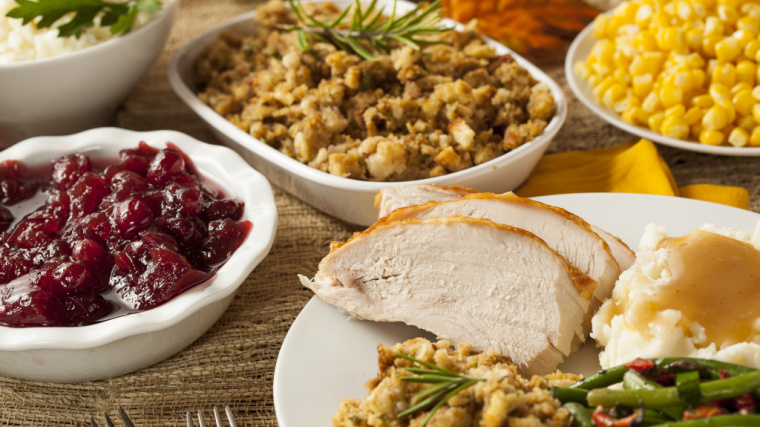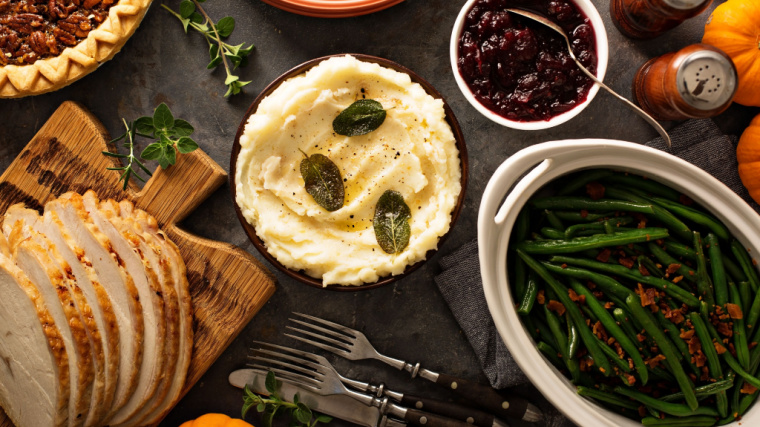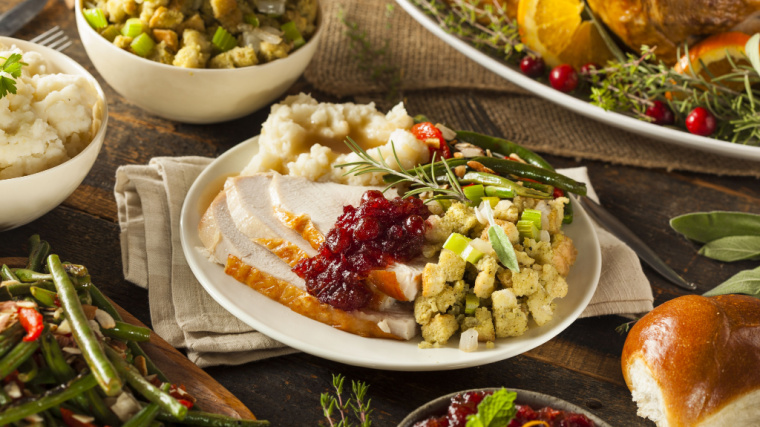As the weather gets cooler and holidays come around, family feasts might well become more common in your life. If your family does Thanksgiving together, you might find yourself traveling across the country, figuring out how to maintain your training schedule, and looking forward to all kinds of tasty casseroles and pies.

For strength athletes, food can be an incredible source of fuel and fun — but it can also be a source of stress. This can be especially true around the holidays. Figuring out how to create a healthy Thanksgiving plate can be tough, but it’s far from impossible. Here’s how to put together the healthiest Thanksgiving plate for yourself, your body, and your goals.
Fitness Goals on Thanksgiving
What you consider to be a healthy Thanksgiving plate is going to depend on your fitness goals. If you’re a bodybuilder prepping for a contest, you’ll have a much different experience at a holiday meal than a strongwoman gearing up to hoist the heaviest Atlas stone load of your career.
But those are two extremes of the fitness spectrum. You’re likely to fall somewhere in between. Maybe you’re a CrossFitter who wants to improve your functional fitness while gaining muscle. Or you might be a powerlifter who wants to shed some pounds so you can feel better about how you move on and off the platform.
Whatever your goals, they’re going to inform what you want your Thanksgiving meal to look like. An athlete’s Thanksgiving dinner is going to look different depending on what their goals are — and on what their needs are as an individual outside of the gym.
What Is Auto-Regulation?
Auto-regulation — also known as self-regulation — is one intuitive approach to eating that involves listening to your body’s own cues about when you’re hungry and when you’re full. When you’re skilled at auto-regulating your food intake, it means you’re approaching your food intuitively and mindfully.
Pay attention to your body’s hunger cues. Ask yourself whether you’re currently eating because you’re hungry, bored, stressed, or happy. Does what you’re putting in your body align with your physical and emotional goals? Self-regulation means taking a flexible approach to your nutritional plan that accounts for nuance and special circumstances — like big family meals.

This approach to nutrition means that you’ll pay attention to what you’re eating, and why you’re eating it, and balance that with what your overarching goals are. Here are some factors you’ll want to pay attention to if you’d like to auto-regulate your Thanksgiving plate.
Are You Eating a Lot?
Holiday meals can come with plenty of stress — and it’s not always about the food itself. Family gatherings can be magnificent for re-setting and reconnecting with your life goals outside of the gym. But, they can also carry their fair share of stress. This stress can impact how (and why) you eat.
Ask questions about why you’re going for that plate of seconds (or not). If you find yourself eating past the point of your stomach being full, you might find that it’s because you’re having fun. On the other hand, it’s common to tuck in to have something to do during a family scuffle that rises to the level of powerlifters debating sumo versus conventional deadlifting.
These questions can be a crucial part of self-regulation.
Are You Eating Very Little?
Similarly, you might find that you’re only nibbling at your plate — perhaps to the point of being very hungry despite an abundance of food. This could be because of nerves or family pressure or expectations about what your body should look like or what you should eat. It might also be because you grazed while you were cooking the feast and you’re just not hungry.
If that’s the case, there’s no need to pile your plate high with food and clear it. You can enjoy the feast on your own terms when the family clears out and it’s just you, a big Tupperware, and your kitchen.
When you know all that delicious seitan loaf is going to be gone if you don’t grab a plate right now, try making a plate for yourself and setting it aside instead of eating it right away. That way, you’re less likely to eat for the sake of not missing out, even if you’re not hungry.
How Hungry Are You?
All of these questions are ultimately about asking how hungry you really are. At each moment of your Thanksgiving meal — as well as before and after — your body will have a lot of feelings. Check in with yourself about how you’re feeling about that next forkful and why you want (or don’t want) to take it.
Maybe you’ve been a little extra focused on fruits and veggies throughout the week to prep for an overload of kugel and turkey. In that case, it might feel good to tuck into those treats. Or you might have been looking forward to that apple pie, but you’re just not feeling it at the moment. Don’t forget the power of putting away a plate for later if needed.
Your Guide to a Healthy Thanksgiving Plate
Different kinds of strength athletes have all sorts of needs and approaches to food and nutrition. What constitutes a healthy Thanksgiving plate for a powerlifter looking to bulk up is different than a healthy plate for a powerlifter looking to maintain mass or even lose body fat.
Here, you’ll find the factors to consider to figure out what you need to do to make the healthiest plate for yourself.
Your General Nutrition
Your Thanksgiving meal doesn’t exist in a vacuum. Every day, you use a certain amount of energy, and every day you eat a certain amount — and type — of food. Despite your best efforts, the holidays often throw your routine out of the proverbial window.
Still, Thanksgiving day isn’t the only day you’ll be eating throughout the week. What, how, and how much you eat throughout the rest of the week may impact what you choose to eat on Thanksgiving.
If your travel-back-to-your-hometown meal on Wednesday night was a heaping plate of pasta with no fruits or veggies in site, your body might be craving greens on Thursday. On the other hand, if you’re the type who has trouble eating on the road, your goals and needs might be better served by replenishing your body with stuffing and ham.
Create a Portioned Plate
You’ll also want to consider what your macronutrient needs — protein, carbs, and fats — are. A general rule of thumb for strength athletes to follow is:
- 1.5-2 grams of protein per kilogram of body weight
- 5-8 grams of carbohydrates per kilogram of body weight
- 0.5-1 gram of fat per kilogram of body weight
The precise intake you need varies based on your body and your goals. With BarBend’s macronutrient calculator, you can give yourself a good idea of how much of each macronutrient you should generally be aiming for.
Macronutrient Calculator
Since many families are going to emphasize protein — think turkey, ham, and seitan roast — on Thanksgiving, you’ve probably got this particular macronutrient on your mind. Find out how much you actually need with BarBend’s protein intake calculator.
Protein Intake Calculator
Knowing what your ideal macronutrient ratios should be is all well and good, but that might not be all that helpful during the holidays. The hustle and bustle of a family Thanksgiving meal is often not the best time to whip out your food scale.
Instead, opt for planning your plate for the estimated portions you want and need. Instead of starting your plate with the protein, try loading on the veggies first, which often will take up half of your plate. Add a fistful of that starchy goodness in the form of yams, kugel, and stuffing and a palm-sized portion of protein like turkey or lentil meatloaf.
On a regular meal-prepping evening, you might toss in one or two thumb-sizes of fat, but at Thanksgiving, these will often be cooked into the mix already.
Adjust these portions according to the levels of macronutrients that suit your goals and give you the grace to enjoy your holiday faves.
Eat Mindfully
It’s all too easy to get lost in the chaos of family and in spending time with those little cousins you haven’t seen in far too long. And while that’s great for your soul, eating while distracted can often lead you to eat more than you might have been intending to.
This is not to say that you have to isolate yourself to enjoy a family meal. But it might serve your fitness goals — and even increase your enjoyment of the food — to slow down and focus on chewing and tasting what’s on your fork. Eating mindfully can help you enjoy your food more while also helping you eat slower.
The slower you eat, the less likely you are to push your stomach past the point of being too full. Being a bit more mindful in the moment can go a long way toward helping you digest your food better and ultimately make nutrition choices a lot more effectively. (1)
Avoid Rigidity
You can create a plan and pile it onto the most balanced Thanksgiving plate in history. But that pecan pie looks really good, and you’ve just got to have some. Even if you have an overall goal of fat loss, research suggests that the best-laid nutrition plans can do more harm than good if you’re extremely rigid about your food choices. (2)(3)
When you go into a meal with the mindset that certain foods are “off-limits,” you’re much more likely to overeat. (2)(3) Instead of telling yourself that you absolutely cannot indulge in certain foods, try giving yourself some permission to let your taste buds enjoy the holidays.
Studies suggest that being more flexible with your food choices can help you achieve more sustainable physique goals than thinking about food in a black-and-white way. (2)(4) So you might want to let yourself sample all the pies, even if your goal is fat loss — science suggests that this degree of flexibility may help you achieve and maintain your goals long-term. (2)(4)
Tips for Eating Healthy on Thanksgiving
The day has arrived. You might be nervous that you won’t be able to maintain your commitment to things like portion control instead of rigid restraint. On the other hand, you might be concerned about dipping the other way and eating until your stomach just doesn’t feel well. Check out these tips for keeping a balanced approach to nutrition on Thanksgiving day.
Have Some Breakfast
Take this one with a grain of salt (pun intended). If you’re the one whipping up the family feast, you may not want (or have time) to eat breakfast. Since you’ll likely be cooking from the moment you get up, you’re likely to be grazing on the veggies you’re chopping and sampling the food you’re preparing. If that’s the case, you might consider this your breakfast (and lunch).
But if you’re not responsible for the feast this year, you might be tempted to skip breakfast to “make room” for dinner. But if your goal is moderation, going into the meal extremely hungry may be counterproductive. You may wind up eating way more than breakfast and lunch’s worth of dinner if you come to the table with major hunger pains.
So skip breakfast at your own potential peril. Instead, opt to have some fruit and yogurt to start your day with a wholesome breakfast before the feast begins.
Train Early in the Day
If you’re planning to work out on Thanksgiving day, you might want to do so early in the day. By working out early, you’ll avoid the potential complications of not being able to move due to a food coma after the meal.
After all, even moderation at the Thanksgiving table may well be a lot more than you’re used to eating. Plus, you may not want to experience the FOMO of leaving the table while everyone else is hanging out.
To make sure you still get your workout in — which can be an important part of feeling good about your body — opt to do so earlier in the day. This way, you’ll get strength training in while you’ve still got the energy and focus.
Plan Your Plate
Chances are, you’re very familiar with the meal you’re about to have. It might well be the same one you’ve been having on Thanksgiving since you were a kid. You might also be forming new traditions with your family, in which case your new fam might be excitedly coordinating who is bringing which dish. Either way, you probably have some idea of what’s on the menu.

Spend some time thinking about what you’re excited to eat and prioritize that on your plate. Consider your goals and how they mesh with your excitement. Plan accordingly. Consider using a smaller plate so that you can get the emotional satisfaction of going back for seconds (and thirds) without getting quite as uncomfortably full.
Build Your Confidence
It can be tough to grapple with the complications of meshing family dynamics with food. You may be faced with age-old comments about how you need to eat more (even if you don’t want to) or you should eat less (even if you’re hungry). Consider preparing a polite but firm response for relatives who might put some pressure on you regarding your food choices.
If possible, recruit backup from your partner, siblings, or other family members that are familiar with and supportive of your goals and needs. Consider making a list of your favorite things about your body — maybe you just hit a new PR (personal record), for example — to keep in mind if you start feeling bad about what you’re eating (or not eating).
Make Your Plate (And Eat It, Too)
The holidays can be a complicated time for your fitness goals. With all the travel workouts and disruptions to your regularly-scheduled meal prepping, it can be easy to toss up your hands and call it all a wash.
Instead of surrendering your goals before Thanksgiving even arrives, some mental prep can come in handy. With a bit of reflection and knowledge about your macronutrient needs and eating habits, you can create a healthy, tasty Thanksgiving plate that supports your goals in and out of the gym.
References
- Cherpak CE. Mindful Eating: A Review Of How The Stress-Digestion-Mindfulness Triad May Modulate And Improve Gastrointestinal And Digestive Function. Integr Med (Encinitas). 2019 Aug;18(4):48-53.
- Ogden, J. (2010). The psychology of eating: From healthy to disordered behavior, 2nd ed. In The psychology of eating: From healthy to disordered behavior, 2nd ed. (pp. xii, 378–xii, 378). Wiley-Blackwell.
- Palascha, A., van Kleef, E., & van Trijp, H. C. (2015). How does thinking in Black and White terms relate to eating behavior and weight regain? Journal of Health Psychology, 20(5), 638–648.
- Lowe, M. R. (2015). Dieting: proxy or cause of future weight gain? Obesity Reviews, 16(S1), 19–24.
Featured Image: Brent Hofacker / Shutterstock